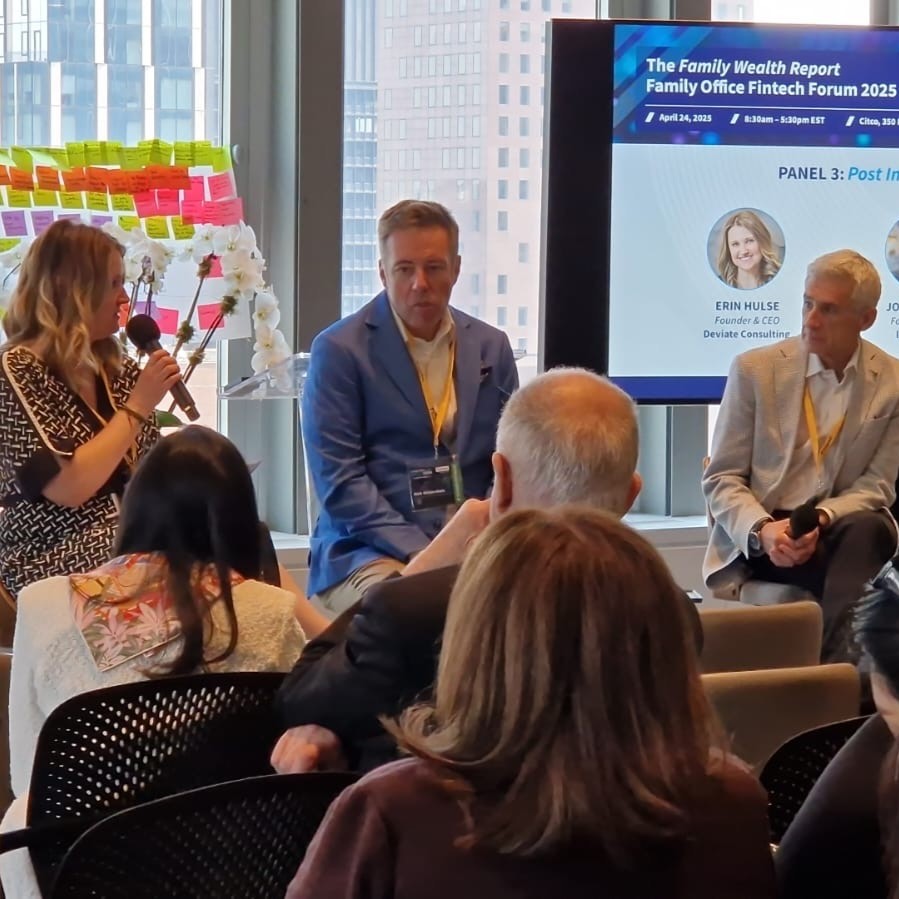Technology
The Importance Of Reviewing Tech Implementation

Among the take-home points of the panel was that ultimately, the process of seeking a new technology solution can be made less taxing with a few key planning benchmarks.
As part of a series (see an example here), the folowing article is a summary of one of the panel discussions in last week’s Family Wealth Report Family Office Fintech Forum, held in New York.
The panelists were Josh Kanter, founder and CEO of leafplanner; Mark Wickersham, of The WealthTech Podcast, and the panel was moderated by Erin Hulse, founder of Deviate Consulting.
(Main photo, from left to right, is Hulse, Kanter and Wickersham.)
After a software implementation is complete, most teams are focused on learning how to accomplish their daily tasks in the new software platform. Taking time to review the implementation, including system setup, functionality, additional training, reporting, and learning new system features is an important ongoing step in the process but is often overlooked. This panel provided benefits and the “why” behind optimizing a Post Implementation Review within any family office.
A software implementation is a large-scale investment, not just fiscally but from a labor and time standpoint and deciding how an implementation will be resourced going in, is often part of the planning phase. Bringing in a consulting team or external expert from outside to lead the family office staff to accomplish such a heavy lift is often found to be a wise decision.
Such a resource can also help lend insights into best practices, niche tech features from varying vendors, and user-experience enhancements, as well as expedite tasks while the day-to-day family office operations can stay in-tact. Following the implementation, the same external consultants can lead the charge in the review process spanning each of those topics listed above, that is intentional and founded on the goals of greater efficiency, rather than what we commonly see in human nature within any workplace after a large change in ops – the office team voicing frustrations while learning on-the-fly how to operate a new system.
This brought about another sentiment from everyone on the panel, that a post-implementation review does not have a timestamp. Such a process might be ideal for most in the months following a new tech onboarding, but it may make sense even years later, as an inventory of the office’s operational needs becomes valuable in deciding, “Is the system we currently use, still working for us as we had hoped?” Sometimes it’s as simple as realizing that only a small number of features are being tapped into, user-stagnation perhaps crept up as the standard, or that ever changing financial data needs require an updated approach to optimize the system’s value, after so many years of using a SaaS.
Asking a tech vendor the right questions before, during, and after implementation was noted as a crucial part of the journey in any selection experience. Again, experts in the tech industry, often consultants, that have knowledge of multiple systems can provide the level of depth needed and can take questions to a more granular level parallel to the vendors, freeing up the leads in a family office to worry about more important matters and keeping their team’s morale at the forefront of daily objectives.
Beyond just the focus on features within a platform, questions like, “Does the vendor provide ongoing professional development to our team?” And “What does client support look like? Is it a call center or other style of assistance? What can your platform offer us in the future regarding X, Y, Z?” Questions that are not always top-of-mind but make a difference following an implementation for long-term user success. Perhaps the vendor-client relationship and/or agreement even includes a dedicated vendor representative to be part of an implementation review a few months after launch?
Each family office is different and that is worth considering via a post-implementation Review as well. Staffing make-up and operations vary. What was promised as a solution for one office may not turn out to be what was intended as the day-to-day experience in the end for every office, so a formal post-implementation review opens the discussion for healthy dialog, minimized conflicts, and mitigated pathways to solving challenges by involving all stakeholders that use and access the system on a normal basis.
Ultimately, the process of seeking a new technology solution can be made less taxing with a few key planning benchmarks. Due diligence in selecting the software is of course crucial, but don’t let the timeframe after the implementation turn into a feeling of “abyss” when just a little bit of time spent following up after the implementation could have positive impact for years on not only a software choice made today, but potential software integrations in the future of the family office.